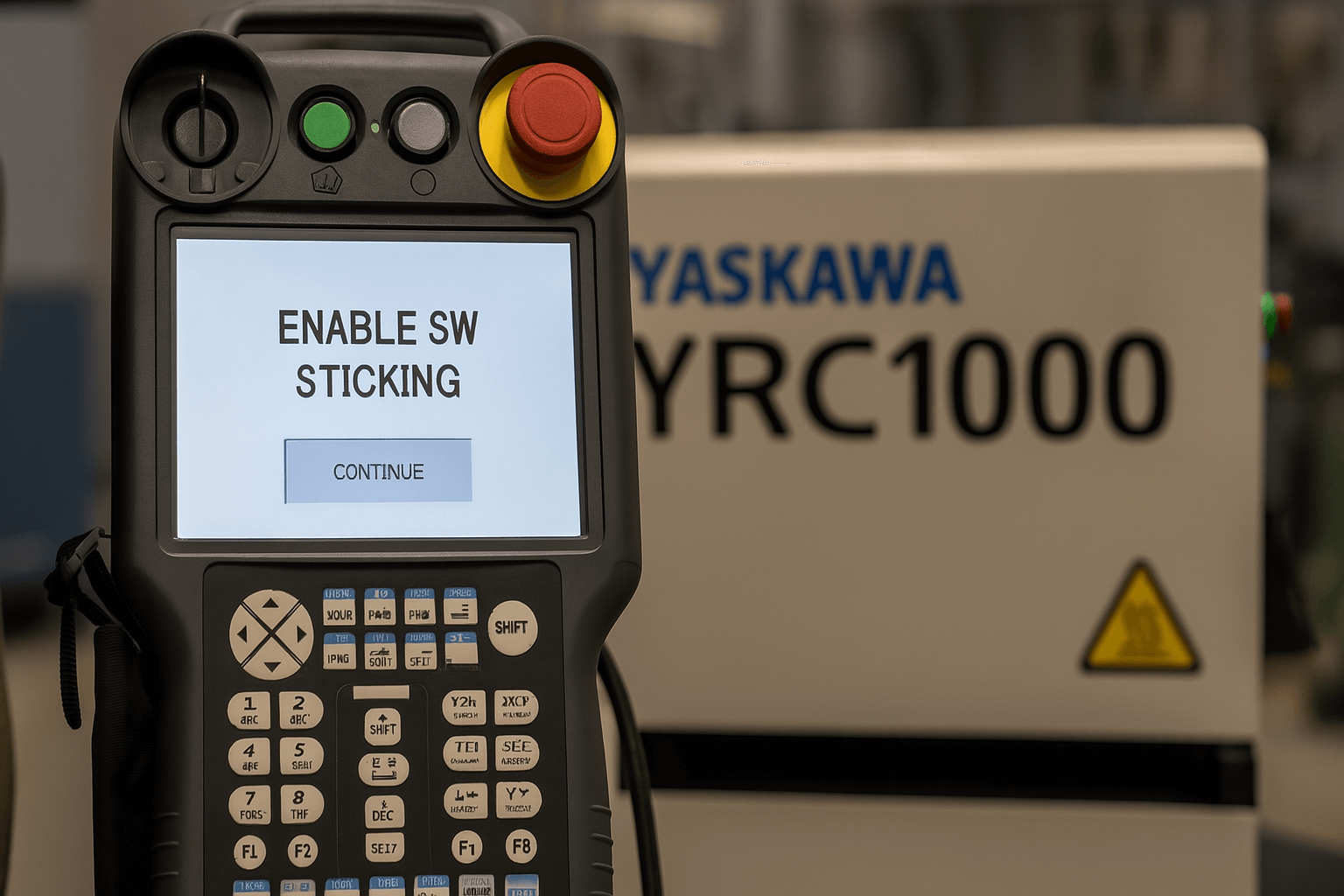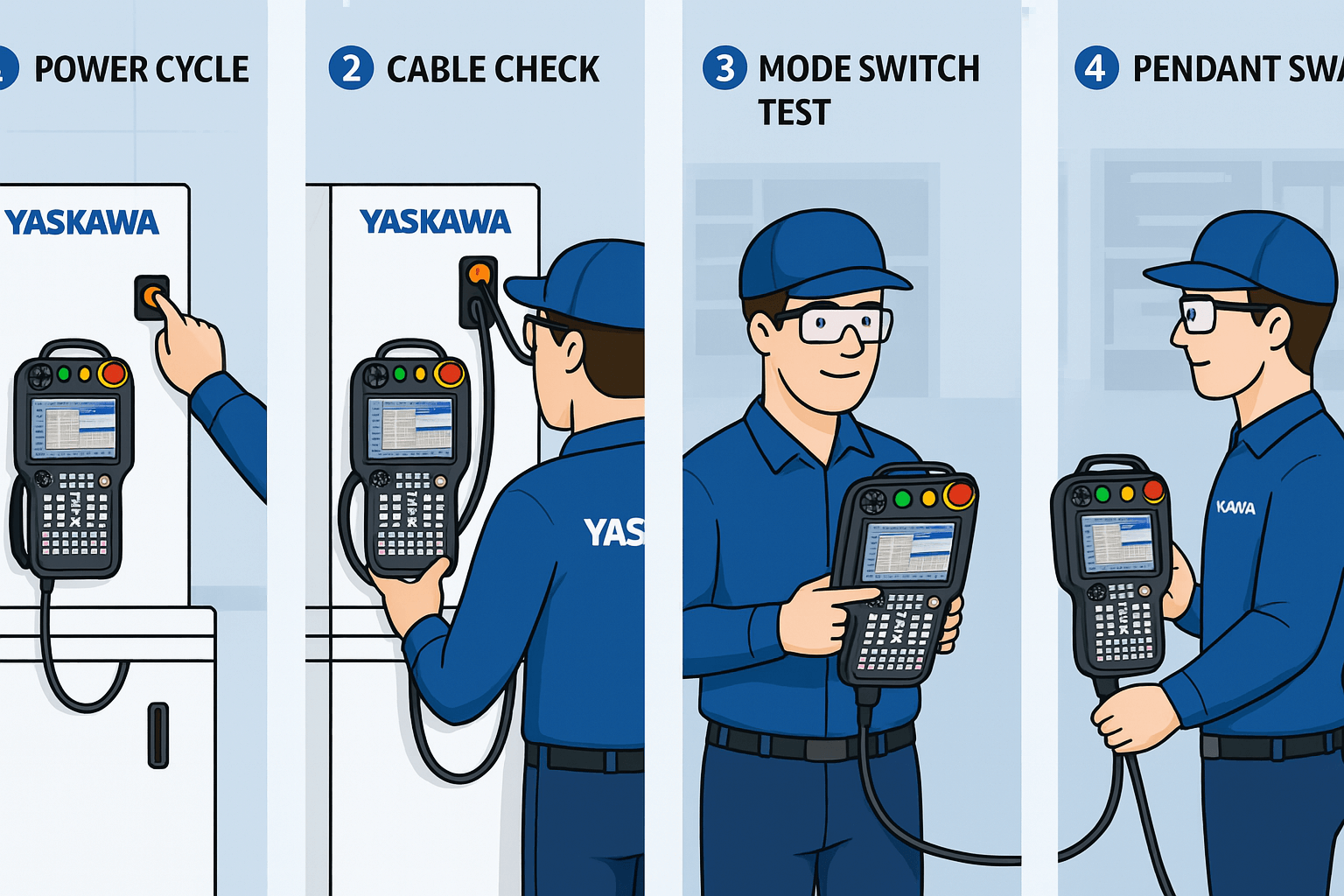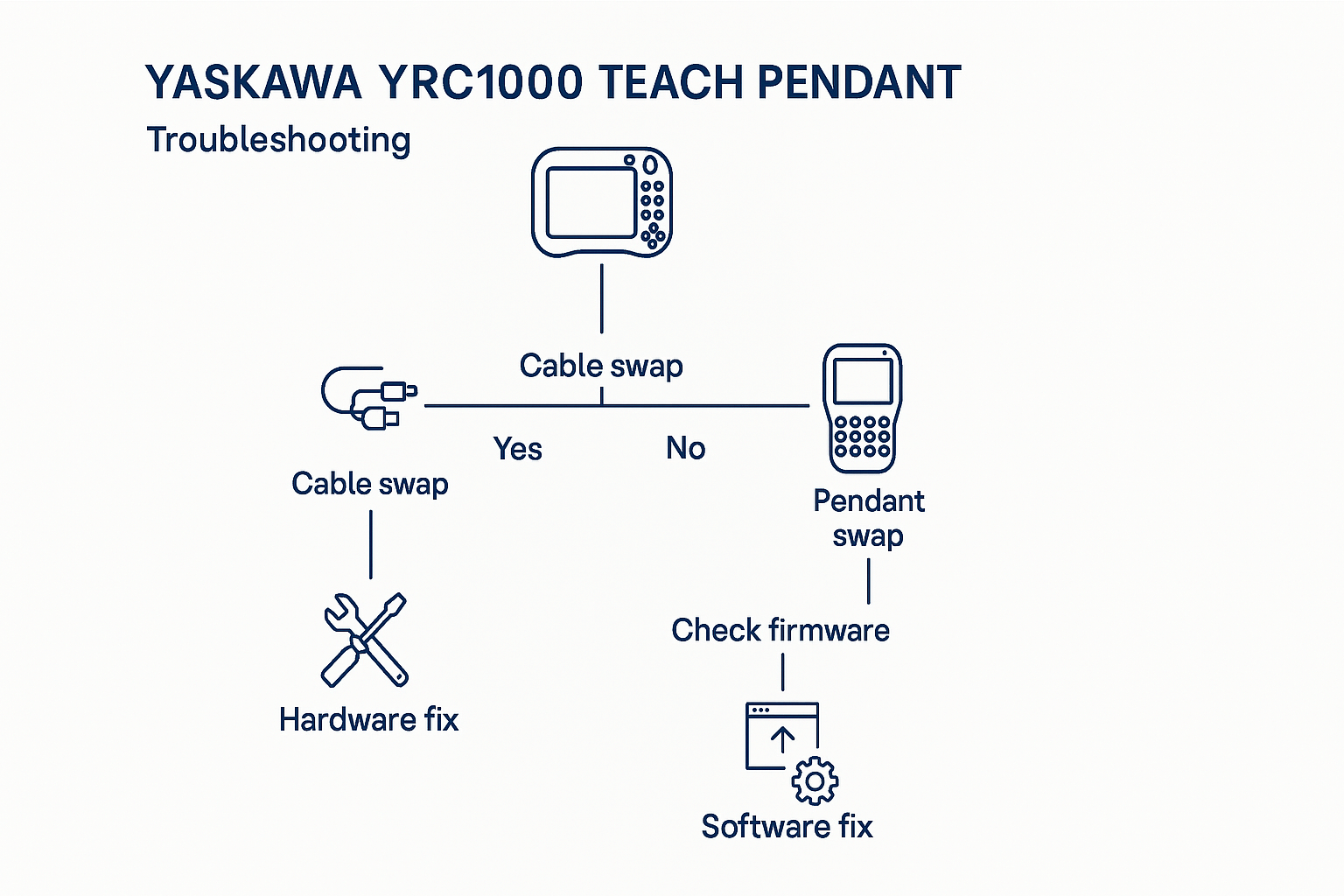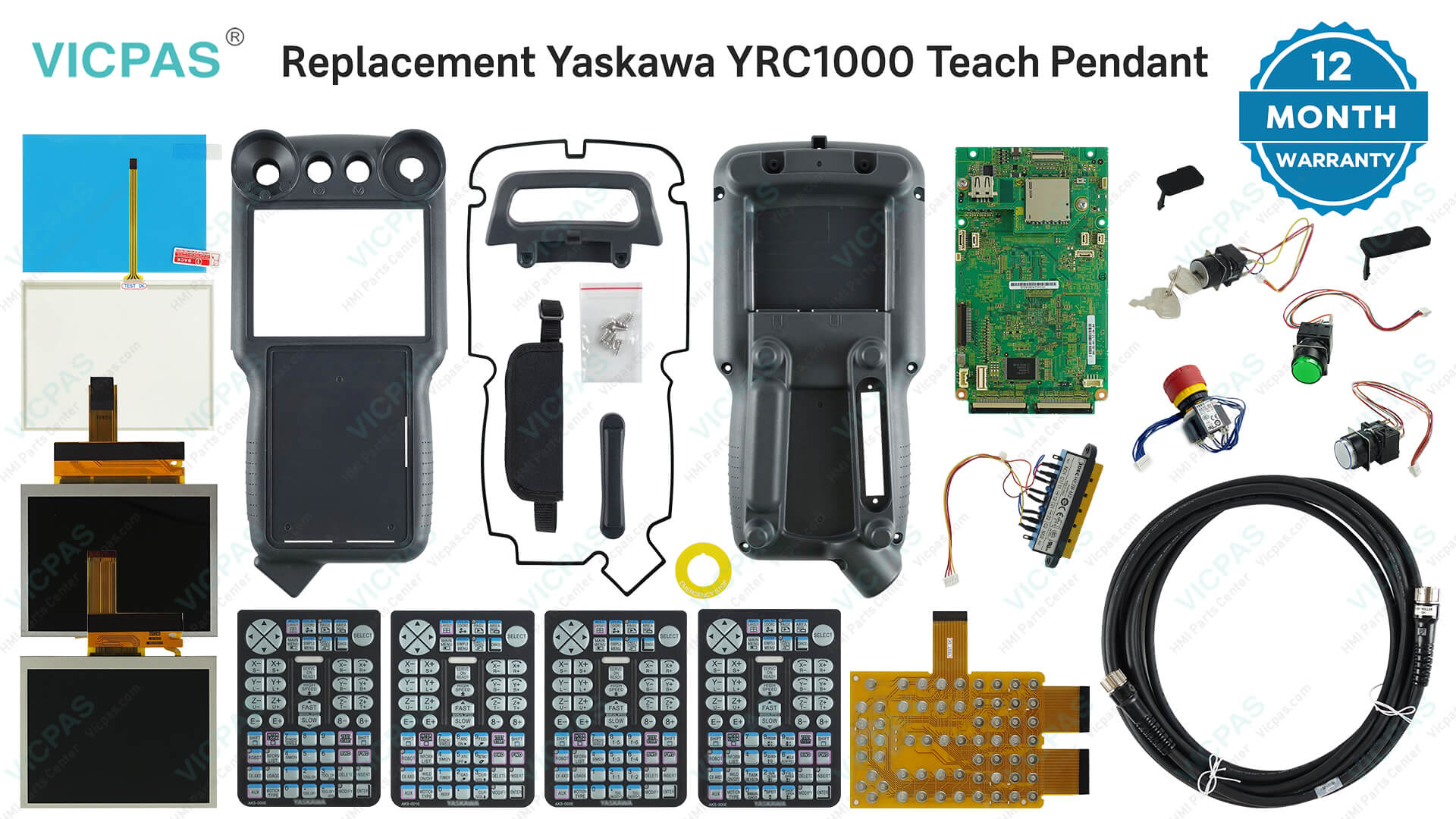- Home
- About us
- Products
- for Siemens
- Agricultural Terminal
- for A-B-B
- Advantech
- Allen Bradley
- AMTouch
- B&R Power Panel
- BECKHOFF HMI operator Repair
- Beijer HMI
- Bosch Rexroth
- Danielson Touch Screen Replacement
- Delem
- Delta
- DMC
- EATON Micro Panel
- ELO Touch Screen Panel
- ESA HMI
- Exor UniOP
- EZ Automation
- Fagor
- Fuji Hakko
- GE Fanuc
- GUNZE Touch Panel
- IDEC
- John Deere
- Koyo
- KUKA SmartPAD
- Lenze
- Microtouch 3M Versatouch touch screen
- Mitsubishi
- Omron
- Panasonic
- Parker
- Proface
- Red Lion
- Robotic Controller
- Schneider
- Sigmatek HMI
- Trimble
- Ventilator Parts
- Weinview
- Other Terminal Brand
- HMI Touch Screen Panel
- Touch Panel Screen Suppliers
- Touch Screen Panel supplier
- Auxiliary Accessories
- LCD Display
- Faqs
- News
- Certificate
- Contact us
Troubleshooting Yaskawa YRC1000 Teach Pendant: Common Problems and Fixes
Troubleshooting Yaskawa YRC1000 Teach Pendant: Common Problems and Fixes
Table of Contents
- Why the Yaskawa YRC1000 Teach Pendant Fails: Common Issues
- Step-by-Step Troubleshooting for Yaskawa YRC1000 Teach Pendant
- Mapping Common Alarm Codes to Fixes
- Hardware vs. Software Decision Tree
- When to Replace: Checklist and VICPAS Solutions
- Final Thoughts: Minimize Downtime with Expert Support
- References
As an industrial automation specialist with over 20 years of experience in HMI and robot controller components, VICPAS Touch Technology Co., Ltd. understands the critical role the Yaskawa YRC1000 Teach Pendant plays in seamless robot programming and operation. Downtime from teach pendant issues can halt production lines, leading to costly delays. In this comprehensive guide, we'll dive into the most common problems with the Yaskawa YRC1000 Teach Pendant, backed by official Yaskawa manuals, community insights, and expert diagnostics. Whether you're dealing with connection failures or alarm codes, we'll provide actionable fixes to get your system back online quickly.
At VICPAS, we specialize in high-quality replacement parts and custom HMI solutions for Yaskawa systems, ensuring compatibility and reliability. Our 12-month warranty and worldwide shipping make us a trusted partner for maintaining your Yaskawa YRC1000 Teach Pendant. Explore our YRC1000-compatible parts here.

Why the Yaskawa YRC1000 Teach Pendant Fails: Common Issues
The Yaskawa YRC1000 Teach Pendant is a robust HMI device for jogging, teaching positions, and monitoring, but it's susceptible to wear from daily use in harsh environments. Based on Yaskawa's official alarm lists and real-world reports from robot forums, here are the top problems:
- Enable Switch Sticking or Diagnosis Errors: The pendant's enable switch fails to release properly, triggering alarms like 1219 (ENABLE SW STICKING) or 1227 (ENABLE SW DIAGNOSIS ERROR). Causes include debris buildup or mechanical wear.
- Connection Failures: "Controller - Pendant Connection Failed" errors often stem from incompatible pendants (e.g., DX100 models on NX100/YRC1000 systems), frayed cables, or loose connectors.
- Frozen or Black Screens: Display issues from firmware corruption, power glitches, or damaged LCDs, common in high-vibration setups.
- Unresponsive Buttons/Touchscreen: Worn membranes or contamination leading to jog or navigation failures during programming.
- Programming and Motion Errors: Mid-path interruptions (e.g., external hold signals triggering premature outputs) or invalid taught points causing alarms like 4498 (no control group) or 4733 (singular posture).
- Software/Communication Timeouts: Mismatched firmware or I/O board faults, especially with Simple-Connect or Moto+ integrations.
These issues align with insights from Yaskawa's maintenance manuals and community threads, where users report 70% of problems resolving via basic checks.
Step-by-Step Troubleshooting for Yaskawa YRC1000 Teach Pendant
Follow this proven sequence—starting with quick tech checks—to diagnose and fix most Yaskawa YRC1000 Teach Pendant issues. We've drawn from official Yaskawa instructions and forum diagnostics for reliability.
Step 1: Power and LED Check
- What to Do: Power cycle the controller (OFF for 30 seconds, then ON). Verify LED indicators on the pendant and controller (e.g., green for power, no red error lights).
- Why It Works: Resets transient glitches like watchdog timeouts (alarms 0927–0987).
- Expected Outcome: If the screen boots normally, proceed to operation tests.
Step 2: E-Stop and Mode Switch Verification
- What to Do: Release the E-Stop, ensure the pendant is in T1 (Teach) mode, and test the enable switch (half-press to enable motion).
- Common Fix: For sticking switches, clean with isopropyl alcohol and test in maintenance mode.
- Pro Tip: Always hook the pendant securely after use to avoid accidental triggers.
Step 3: Cable Continuity and Connection Test
- What to Do: Inspect CN509/CN515 cables for frays or loose pins using a multimeter. Swap with a known-good cable if available.
- Diagnosis: If the error persists post-swap, it's likely a controller I/O issue (e.g., AIF01 board fault).
- From Forums: Users resolved 80% of "Connection Failed" errors by confirming NX100-compatible pendants (JZRCR-NPP01-1).
Step 4: Swap Pendant to a Known-Good Controller
- What to Do: Connect the pendant to another YRC1000 system. If it works, the issue is controller-side (e.g., SDCA01 board).
- Backup First: Save CMOS.BIN via maintenance mode before any swaps.

Mapping Common Alarm Codes to Fixes
Referencing Yaskawa's YRC1000 Alarm Codes manual, here's a table of pendant-related alarms with causes and resolutions:
| Alarm Code | Description | Cause | Fix |
|---|---|---|---|
| 1219 | ENABLE SW STICKING | Debris or wear on enable switch | Power cycle; clean switch; replace pendant if persistent. Save CMOS.BIN and contact Yaskawa. |
| 1227 | ENABLE SW DIAGNOSIS ERROR | Faulty signal judgment in safety circuit | Boot with switch released; replace pendant. Verify wiring to ASF01 board. |
| 0010–0021 | Board/Communication Errors | Loose CN509 insertion or SD card corruption | Check rotary switches on SDCA01; reseat cables; transfer CMOS.BIN to new board. |
| 4498 | No Control Group | Undefined group in teaching | Re-teach in maintenance mode; verify parameters (AxP010). |
| 4733 | Singular Posture | Invalid joint angles during jog/teach | Adjust posture to avoid singularities; reduce speed <250mm/s. |
| 4780–4799 | F-SAFE Errors | Safety range/speed violations in manual mode | Update safety files; check tool calibration. |
For full lists, download the YRC1000 Alarm Codes PDF.
Hardware vs. Software Decision Tree
Use this simple tree to pinpoint if your Yaskawa YRC1000 Teach Pendant issue is hardware or software-based:
- Start: Does swapping the cable fix it?
- Yes → Hardware: Replace frayed cable (CN515/CN516).
- No → Proceed.
- Next: Does swapping to a known-good pendant resolve it?
- Yes → Hardware: Repair/replace pendant (e.g., screen or buttons via VICPAS refurb kits).
- No → Software: Check firmware version in maintenance mode.
- Firmware Check: Mismatch? Reload recovery image from Yaskawa USB (cite Simple-Connect notes). If corrupted, backup CMOS.BIN and restore.
- Still Failing? → Controller issue: Inspect I/O boards; contact certified service.
This approach, inspired by robots.com diagnostics and forum threads, cuts resolution time by 50%.

When to Replace: Checklist and VICPAS Solutions
If basic fixes fail, it's time to replace. Use this checklist:
- Alarm persists after power cycle and swaps.
- Physical damage (cracks, unresponsive E-stop).
- Firmware reload doesn't resolve boot errors.
- Cost of repair exceeds 50% of new/refurb unit.
Don't risk downtime—VICPAS offers premium Yaskawa YRC1000 Teach Pendant replacements and custom HMI parts, fully compatible with your controller. With our expertise in obsolete automation components, we provide:
- Refurbished pendants with 1-year warranty.
- Custom button overlays and cable assemblies.
- Fast quotes and same-day global shipping.
Shop VICPAS YRC1000 parts now and keep your operations running smoothly. Our engineers have serviced thousands of Yaskawa systems, ensuring EEAT-compliant solutions you can trust.

Final Thoughts: Minimize Downtime with Expert Support
Troubleshooting your Yaskawa YRC1000 Teach Pendant doesn't have to be overwhelming. By following these steps and leveraging official resources, you can resolve 90% of issues in-house. For persistent problems or upgrades, partner with VICPAS—your go-to for reliable, customized industrial HMI solutions.
Have a specific error? Drop a comment below or contact VICPAS for personalized advice. Stay productive!
References
- YRC1000 — Error Message List (Yaskawa / Motoman Knowledge Center)
- YRC1000: Instructions (Yaskawa / Motoman Knowledge Center)
- YRC1000 Alarm Codes (Operator Manual PDF)
- YRC1000 Controller Manual / Programming Pendant Instructions
- Robot-Forum — Yaskawa YRC1000 Programming Issues
- Robot-Forum — Controller - Pendant Connection Failed
- Robot-Forum — YRC1000 Installation & Manuals
- Teach Pendant Repair: Diagnosing Common Teach-Pendant Failures (robots.com)
- YouTube — Yaskawa YRC1000: Check Position & Error Recovery
- Simple-Connect / Moto+ Pendant Socket Errors (Yaskawa Knowledge)
- VICPAS Touch Technology Co., Ltd.
